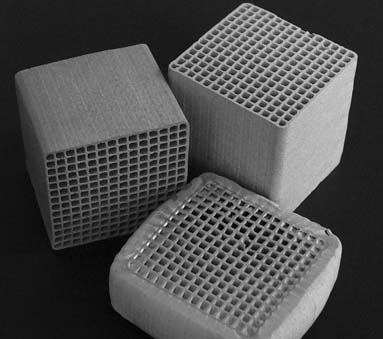The combination of two or more different materials offers a range of advantages. Regarding crashworthiness, for instance, composite materials enable manifold possibilities for micro- and macrostructure designs. They can be adapted for the intended application and required characteristics. Crashworthiness is concerned with the absorption of energy through controlled failure mechanisms and modes that enable a defined load profile during deformation.
Combining a ductile metal matrix with brittle ceramic additions leads to failure-tolerant metal-matrix composites (MMC). In this field, transformation-induced-plasticity (TRIP) steels offer a matrix material with outstanding strain associated with slight strain hardening. These properties originate from a phase transformation from austenite to martensite on mechanical load. Similar transformations can be observed for zirconia (ZrO2) ceramics.
In general this phase transformation appears with a volume change exceeding the critical fracture length in ceramics. Whilst this effect eliminates pure zirconia applications the transformation can be used for reinforcing a second material. This was done in a study at the Technische Universität Bergakademie Freiberg (Freiberg University of Mining and Technology) in Germany. The combination of a metastable austenitic TRIP-steel with magnesia partially stabilized zirconia (Mg-PSZ) is presented in this study.
 The researchers applied the ceramic plastic extrusion route at room temperature in order to produce honeycomb macrostructures. This method offers the ability of homogeneous mixtures of steel and ceramic particles in the range of some µm. After sintering the samples were tested under uniaxial compressive load.
The researchers applied the ceramic plastic extrusion route at room temperature in order to produce honeycomb macrostructures. This method offers the ability of homogeneous mixtures of steel and ceramic particles in the range of some µm. After sintering the samples were tested under uniaxial compressive load.
Besides electron microscopy and X-ray microanalysis the German scientists used electron backscatter diffraction (EBSD) for microstructure characterization. EBSD is a technique to examine the crystallographic orientation. It can be used for phase analysis, as EBSP provides all information about the lattice symmetry.
The researchers concluded that the reinforcing mechanism of additions of ceramic particles enables composite materials with superior mechanical properties. Raised compression strength as well as increased specific energy absorption on plastic deformation offers a range of structural and crash-absorption applications.
However, the phase composition of the partially stabilized zirconia particles after sintering has to be changed. The researchers assume a high potential of reinforcing effects of ceramic particles when degreasing the amount of non-transformable zirconia. Furthermore the mechanism of chemical interactions between TRIP-steel matrix and zirconia during sintering has to be investigated in future work.

















